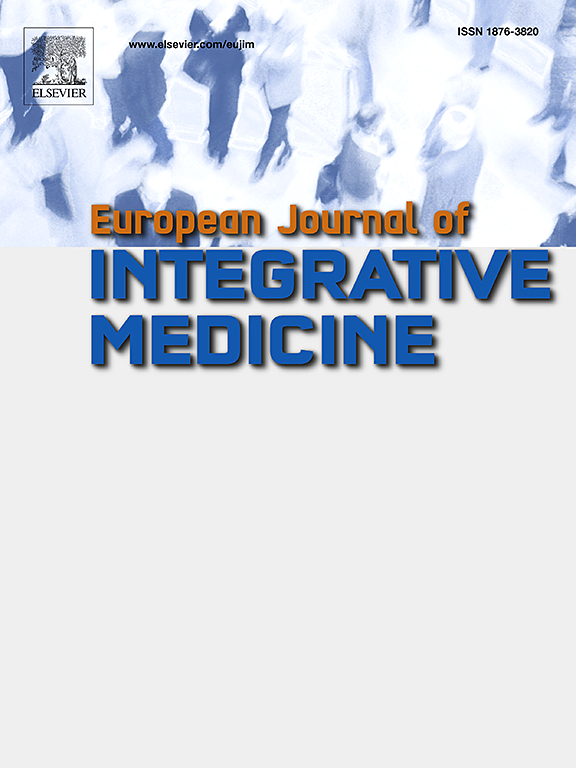金缕草提取物的光动力学和细胞毒活性:分子相互作用和抗氧化潜力
IF 1.7
4区 医学
Q3 INTEGRATIVE & COMPLEMENTARY MEDICINE
引用次数: 0
摘要
本研究主要研究了金缕草甲醇提取物的抗癌、光动力学、抗氧化效率和分子相互作用特性。方法采用IC50评价正常(HEK293)和胃癌(MKN28)细胞株的细胞活力,包括绿光下的光动力活性。通过清除DPPH自由基来评估抗氧化能力,同时分光光度法定量测定植物化学成分含量。气相色谱-质谱(GC-MS)分析确定了主要化合物,分子对接研究探索了它们与靶蛋白的相互作用。结果细胞活力测定显示,HEK293的IC50值为1036 μg/mL, MKN28的IC50值为951.8 μg/mL。采用绿光评价其光动力学活性,正常细胞IC50值为56.62 μg/mL,癌细胞IC50值为32.53 μg/mL。与正常细胞相比,在癌细胞中观察到更明显的细胞活力降低。然而,当浓度约为正常细胞IC50值的1/18和癌细胞IC50值的1/29时,它显示出显著的光动力活性。该提取物的DPPH自由基清除IC₅₀值为154.15±1.04µg/mL,具有较强的抗氧化活性,比BHT(230±10µg/mL)更强。总黄酮、类黄酮、酚类、原花青素和单宁含量分别为24.30±1.23 mg QE/g、32.96±3.23 mg QE/g、6.31±0.79 mg GAE/g、83.41±12.95 mg CAE/g和27.32±2.30 mg GAE/g。GC-MS分析显示,肌醇(30.47%)、4-((1E) -羟基-1-丙烯基)-2-甲氧基苯酚(23.04%)、3-氨基-2,6-二甲基吡啶(7.41%)和3-丁烯-2- 1,4 -(4 -羟基-2,2,6-三甲基-7-oxabicyclo[4.1.0] -1-基)(5.99%)是主要成分。分子对接研究表明,3-丁烯-2- 1,4 -(4 -羟基-2,2,6-三甲基-7- oxabicycloo [4.1.0] -1- hpt - 1-yl)与BAF络合物(6LTJ)表现出强的结合作用,肌醇表现出明显的氢键作用,4-((1E) -羟基-1-丙烯基)-2-甲氧基苯酚与多种受体表现出显著的结合作用。结论桃金娘提取物具有较强的抗氧化活性和一种新型的光动力细胞毒作用,且在绿光照射下表现突出。这些发现表明,提取物可能具有多种治疗潜力。本文章由计算机程序翻译,如有差异,请以英文原文为准。

Photodynamic and cytotoxic activities of Onosma aucheriana extract: Molecular interactions and antioxidant potential
Introduction
This study investigates the anticancer, photodynamic, antioxidant efficiency and molecular interaction profiles of Onosma aucheriana methanol extract.
Method
The cell viability of normal (HEK293) and gastric cancer (MKN28) cell lines was evaluated using IC50 values, including photodynamic activity under green light. Antioxidant potential was assessed through DPPH radical scavenging, while phytochemical contents were quantified spectrophotometrically. Gas chromatography-mass spectrometry (GC–MS) analysis identified major compounds, and molecular docking studies explored their interactions with target proteins.
Results
Cell viability assays showed a dose-dependent reduction in cell viability, with IC50 values of 1036 μg/mL for HEK293 and 951.8 μg/mL for MKN28. To assess photodynamic activity, green light was used, revealing IC50 values of 56.62 μg/mL for normal cells and 32.53 μg/mL for cancer cells. A more pronounced reduction in cell viability was observed in cancer cells compared to normal cells. However, it demonstrates significant photodynamic activity at a concentration approximately 1/18th of the IC50 value for normal cells and about 1/29th of the IC50 value for cancer cells. The extract, with a DPPH radical scavenging IC₅₀ value of 154.15 ± 1.04 µg/mL, exhibits strong antioxidant activity, which is greater than that of BHT (230 ± 10 µg/mL). The total flavanol, flavonoid, phenolic, proanthocyanidin, and tannin contents are quantified as 24.30 ± 1.23 mg QE/g, 32.96 ± 3.23 mg QE/g, 6.31 ± 0.79 mg GAE/g, 83.41 ± 12.95 mg CAE/g, and 27.32 ± 2.30 mg GAE/g, respectively. GC–MS analysis reveals inositol (30.47 %), 4-((1E)‑hydroxy-1-propenyl)-2-methoxyphenol (23.04 %), 3-amino-2,6-dimethylpyridine (7.41 %), and 3-buten-2-one, 4-(4‑hydroxy-2,2,6-trimethyl-7-oxabicyclo[4.1.0] hept‑1-yl) (5.99 %) as major components. Molecular docking studies reveal that 3-buten-2-one, 4-(4‑hydroxy-2,2,6-trimethyl-7-oxabicyclo[4.1.0] hept‑1-yl) exhibits strong binding interactions with BAF complex (6LTJ), inositol shows substantial hydrogen bonding, and 4-((1E)‑hydroxy-1-propenyl)-2-methoxyphenol demonstrates significant binding with several receptors.
Conclusion
The O. aucheriana extract exhibited strong antioxidant activity and a novel photodynamic cytotoxic effect that became prominent under green light exposure. These findings suggest that the extract may possess versatile therapeutic potential.
求助全文
通过发布文献求助,成功后即可免费获取论文全文。
去求助
来源期刊

European Journal of Integrative Medicine
INTEGRATIVE & COMPLEMENTARY MEDICINE-
CiteScore
4.70
自引率
4.00%
发文量
102
审稿时长
33 days
期刊介绍:
The European Journal of Integrative Medicine (EuJIM) considers manuscripts from a wide range of complementary and integrative health care disciplines, with a particular focus on whole systems approaches, public health, self management and traditional medical systems. The journal strives to connect conventional medicine and evidence based complementary medicine. We encourage submissions reporting research with relevance for integrative clinical practice and interprofessional education.
EuJIM aims to be of interest to both conventional and integrative audiences, including healthcare practitioners, researchers, health care organisations, educationalists, and all those who seek objective and critical information on integrative medicine. To achieve this aim EuJIM provides an innovative international and interdisciplinary platform linking researchers and clinicians.
The journal focuses primarily on original research articles including systematic reviews, randomized controlled trials, other clinical studies, qualitative, observational and epidemiological studies. In addition we welcome short reviews, opinion articles and contributions relating to health services and policy, health economics and psychology.
 求助内容:
求助内容: 应助结果提醒方式:
应助结果提醒方式:


